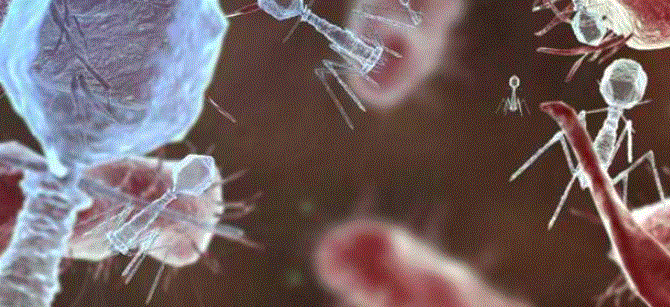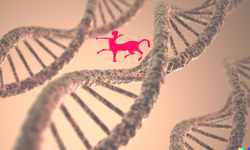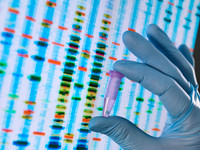
What is a bacteriophage particle?
The phage consists of five coat proteins. The particle includes a hollow tube that houses copies of the primary coat protein. Additionally, there are binding interactions between the adjacent sub-units’ midsections that are hydrophobic. One end of this particle is blunt, and the other one is sharp. The blunt conclusion contains lots of copies of the two most tiny translated proteins, whereas the sharp conclusion contains.
What is a Temperate Phage?
In most cases, temperate phages reel toward the lysogenic cycle particularly when phage absorption from the contaminated bacteria is apparent. It is inferred that other bacteria are currently undergoing the exact same phage infection, making the bacteria fall in density. Due to this”crisis,” the go-to cycle is lysogenic or Lysogenic cycle.
Phage Display
Camel monoclonal antibodies are produced by phage display in E. coli. In 1950, Esther Lederberg, an American microbiologist, was doing experiments on E. coli mixtures. She happened to see streaks of combinations of two kinds of E. coli strains that appeared to have been nibbled on and had viral plaque. One E. coli strain had been treated with ultraviolet light, so the damage was more apparent. It was later ascertained that viruses, which replicated caused this and spread resulting in cell destruction. The discovery resulted in the employment of Lambda phage as a model organism in microbial genetics in addition to in genetics.
Because phages are target specific, meaning just a one or very few bacterial strains are targeted upon, it’s easier to create new phages than new antibiotics. A time period of months or only a couple of days is needed to obtain new phages for resistant strains of germs, whereas it can take years to obtain antibiotics. When resisting germs evolve, the assigned phages also evolve, so an equivalent super phage fights it provided that the phage is derived from precisely the same atmosphere, when super bacterium appears.
What are the applications of phages?
Bacteriophages have several applications. In certain countries such as Russia and other Eastern European nations, phages are used therapeutically for the treatment of pathogenic bacterial infections which are resistant to antibiotics. Also called phage therapy, this method entails the usage of a phage to ruin the infective bacteria like E. coli or salmonella. Bacteriophage is also used in identifying pathogenic bacteria (also referred to as phage typing) in diagnostic labs. 1 other use for bacteriophages is for murdering bacteria. By way of example, LISTEX by Gentaur is composed of bacteriophages that can kill the L. monocytogenes bacteria in cheese.
Decision making is not only done by individuals; it’s also accomplished by temperate phages as they will need to select between two different life cycles, effective (lytic) or reductive (lysogenic). There’s a predominance of lytic among phages, as induction can induce lysogenic to convert to logic.
One of the characteristics of bacteriophages is that their temperateness. Temperateness refers to the ability of some bacteriophages lambda phage, to select between two cycles: lytic or lysogenic. “Temperance” generally indicates the moderation of actions, also in the case of phages, moderation is observed via the capability to never express anti-bacterial virulence.
How functions phage display?
Phage Display is a method wherein a library of phage particles which say very varied peptides is created. The target is to pick those that will bind a desirable goal; the target is a peptide, a protein, or a bit of DNA.
The lytic cycle is just like the lysogenic cycle in that the host DNA machines is used to replicate the phage, but the phage is thought to be a distinct molecule from the host DNA. It becomes a virulent phage Every time the cycle is undergone by a temperate phage. The cell and its membrane disintegrate because the DNA, which is thought to be a separate molecule in the bacterial cell, replicates finally overpowering it.
Determining the appropriate protein partners may be useful to identify the functions of various proteins. For drug discovery and design, Phage Display is used in vitro protein evolution or in protein production. Therapeutic targeting with phage display is primarily used to diagnose and determine tumour antigens, which is beneficial for cancer study.
How camel monoclonals are produced?
Antibody Phage Display considerably enhanced the discovery and development of antibody drugs. Display for antibody libraries paved the way for treatment and vaccine design. These libraries are used to find out more about the immune system and to create antibodies in vitro with the use of varied substances.
A bacteriophage is a type of virus which may infect and replicate itself within bacterial cells. The virus can have simple or complex anatomies and contains a protein-encapsulated DNA or RNA genome. There are various kinds of bacteriophages including MS2, T phage, lambda phage, M13, G4, and Phix174.
What is the structure of phages?
What springs to mind when you hear the word”germs”? Most people, if not all, will answer”disease,””sickness,” or”bad for the health.” What not all people understand is that there are actually bad and good some bacterial species and bacteria are benign. In reality, bacterial infections may be treated with bacteriophages: viruses which possess the ability to infect and fight damaging bacteria, culminating in their destruction. Bacteriophage or phage therapy is thus very helpful in a variety of fields such as medicine, veterinary science, dentistry, as well as agriculture.http://www.newbalanceoutlet.cc
Phage Display can be used in conjunction with other techniques, and with sufficient support and studies, more applications for it may be discovered.
What is a Phage Display Cycle?
The lysogenic cycle, by comparison, does not produce a massive number of progeny phage or break down the host cell. Instead, the λ DNA recombines using its host’s genome to produce a prophage. This is the favoured pathway when unfavourable environmental conditions stop extreme replication of the bacterial cells. Like the cycle, the first step of the cycle is the injection of its DNA and the attachment of the phage into the host cell. The DNA and the host chromosome subsequently integrate, making an incorporated DNA combination. Are said to be in the state. The prophage DNA is duplicated along each period the host bacterial cell replicates itself, making more cells, each with a copy of the prophage DNA. When these cells have been exposed to specific substances or to lighting , phage induction happens; the prophage DNA is then cut into the cycle out of their host genome and proceeds from the Bacteriophage
How functions Phage Therapy?
What about Bacteriophage:
The lambda phage’s capability to mediate genetic recombincation is because of its red operon, which is a functioning unit of genomic DNA which has a bunch of genes controlled by a promoter or a single regulatory signal. This red operon can be extracted to give the proteins red alpha (or exo), beta, and gamma, which may be used in recombination-mediated genetic engineering, a method commonly utilized in bacterial genetics, generation of target vectors, and DNA modification.
So as to infect a host cell, the bacteriophage attaches itself to the bacteria’s cell wall, especially on a receptor located on the bacteria’s surface. When it becomes tightly bound into the mobile, the bacterial virus injects its genetic material (its lipoic acid) into the host cell. Depending on the sort of phage, one of two cycles will occur — both the lytic or the cycle. Throughout a lytic cycle, the phage will make use of the host cell’s chemical energy in addition to its own biosynthetic machinery so as to create phage nucleic acids (phage DNA and phage mRNA) and phage proteins. ) The nucleic acids and proteins are constructed once the production phase is finished. After a time proteins generated within the cell may get the cell wall to lyse, permitting the phages that are assembled inside to be discharged and to infect other cells.
Relating to this
A lambda phage has a mind measuring around 50-60 nanometers in diameter and a flexible tail which are about 150 nanometers long and might include tail fibers.
Http://www.nikeairmaxfreerun.com nike air max sneakers
Compared to antibiotics, phages go deeper to the infected location. Antibiotics, on the other hand, have as they move below the surface of the infection, concentration properties which decrease. The replication of phages is concentrated on the region where they are needed the most, while antibiotics have been metabolized and removed from the body. In addition immunity doesn’t happen among phages but happens often among antibiotics. Secondary resistance is acquired and happens whenever there are not sufficient blood drug levels.
Phage Applications
Background of Phage Therapy
Viruses cannot multiply through the division of cells as they are acellular (they do not have cells). They seek a host cell in which they build and replicate themselves together with the metabolism and machinery of their host cell. Various species of viral inhabitants undergo life cycles that are different, but for phages, as previously mentioned, they need to pick between two.
Phage Display
Before bacteriophages were officially discovered, many bacteriologists from the 1890s had observed an unidentified substance that seemed to be accountable for limiting bacterial activity. These findings were further researched by none of them although they’d noted such a happening. Unfortunately, lack of funding in addition to the beginning of World War I interrupted Twort’s work. 2 decades after, a French-Canadian microbiologist called Félix d’Hérelle created a similar observation and succeeded in discovering exactly what he called”an imperceptible, antagonistic microbe of the dysentery bacillus”. Contrary to the researchers, d’Hérelle was certain that was. He called it a”bacteria-eater” or”bacteriophage”, by the phrase bacteria and the Greek phrase”phagein” so to eat or devour.
Bacteriophages come in various shapes and sizes but the majority of them possess the same basic attributes: a mind or capsid and a tail. The head structure, irrespective of its shape or size of A bacteriophage, is made up of one or more proteins which coats the nucleic acid. Even though there are some phages which don’t possess a tail, the majority of them do have one attached to its mind structure. It is a tube through which the nucleic acid goes through when the bacteriophage infects a host cell. Some of the complex phages like T4 possess in attaching itself into a cell, one or tail fibers which aid the phage as well as a tail with a base plate phone.
Phage Therapy
Software for phages:
Phage therapy has many other possible benefits and giving it ample support can pave the way to a healthier future.
Phage benefits over other systems
The generated phage library is then screened by means of a microtiter plate containing immobilised target proteins or DNA sequences. Phages displaying a protein that binds to a single goal will stay, while another phages can be lost via washing. The rest of the phage particles may be used by infecting them thus increasing the diversity of this peptide display library to multiply the phage.
Skip to content
Viral reproduction may also happen through the lysogenic cycle. The difference between the 2 types of bicycles is the host cell is not destroyed or does not undergo lysis, that through lysogeny. When the host cell is infected, the DNA and the bacterial chromosome incorporates or combine together, producing the prophage. After the bacterium reproduces, the prophage is replicated together with the host chromosomes. Thus, the daughter cells comprise the prophage which carries the potential of phages that are generating. The lysogenic cycle may continue indefinitely (female cells with prophage existing within continuing to replicate) unless subjected to adverse conditions which can trigger the conclusion of the lysogenic state and trigger the manifestation of the phage DNA and also the start of the lytic cycle. These negative conditions include exposure to mutagenic or UV compounds and desiccation.
The lambda phage has different applications, most of which are linked to DNA cloning. This is only because lambda phage can be used as a vector for generating recombinant DNA, which are DNA sequences that result from using lab techniques such as molecular cloning to assemble material from many sources. The recombinase of lambda phage can be used to get shuffling cloned DNAs a molecular biology technique which guarantees the transfer of DNA fragments between plasmids, through the gateway cloning system.
Fighting and destroying bacterial diseases (both in people and animals) are the primary applications of phage therapy, but it can also be utilized for other uses. It can be the key to combating the NDM-1, a gene that can be contained in the DNA of bacteria, enabling them to resist antibiotics. Waste water from sewage systems are not really considered waste because it is a rich supply of phage strains for various kinds of germs that result in the medications. Skin grafting for extensive wounds, injury, burns, and skin cancer may also be improved by employing phage treatment to lessen the Psuedomonas aeruginosa infection. Antitumor agents have been also found by some experiments for cells in tissue culture in phages. Compounds cause food to spoil faster, and phages have been studied for their potential to grow the freshness of food and decrease the incidence of food spoilage.
Applications
Life cycle
History of Phage Display
In many laboratories, temperate phages are considered more of lytic phages because most lytic-lysogenic decisions lead in the prior. If phages are either lytic or lysogenic, it is apparent that they are capable of making a choice, particularly for replication.
Undoubtedly, the lambda phage is a powerful genetic tool that may be used in several significant studies.
The head includes different proteins and over a thousand protein molecules such as X1, X2, B, B, E, D, and W. The mind functions as a capsid which contains its genome, which contains 48,490 base pairs of DNA. This number also has 12-base single-stranded components at its 5′ ends. The components are known as sites and will also be called. Hence, when in form, the genome is comprised of 48,502 pairs in length. The weight of the genome is estimated to be 32×106 Da, which will be approximately half of the weight of the phage.
The lytic cycle happens when progeny phage particles are made. The cycle is the common life cycle that comes after infections. The very first step of this cycle is the attachment of the phage into the host cell, putting its DNA. Acid from the phage is replicated, and the phage’s genes are expressed, permitting the creation of proteins. The phage proteins have been built into phage particles, which are released when the host cell undergoes lysis (it breaks ). The lysis is mediated by genes R, , Rz, and Rz1 which, upon expression, yield proteins that work together to divide the cell wall of the host bacterium. Many phage particles are usually yielded by this mode of lambda replication.
The lytic-lysogeny decision
Bacteriophages were discovered by two individuals: the English bacteriologist Frederick Twort in 1915 and the French-Canadian microbiologist Felix d’Herelle at 1917. After their discovery, the thought of using phages to resist infections was apparent. D’Herelle started testing the therapeutic effects that phages could have on chickens and cows and the tests were successful. Eventually tests have been conducted and the progression of phage treatment became more extensive especially with the foundation of their Eliavia Institute at 1923; the pharmaceutical firm Eli Lilly began the commercialization of phage treatment during the 1940s. During the Second World War, phages were used to treat diseases particularly gangrene and dysentery. Since the use of antibiotics became favourable, the development of antibiotics in the 1950s led to a temporary setback on phage treatment. There has been a renewed interest in more applications in employment and the evolution of phage treatment.
Bacteriophage
The very first described instance of Phage Display occurred in 1985, when George P. Smith fused a peptide with a gene III from a filamentous phage. He filed a patent outlining the process of generating display libraries. Further evolution of Phage Display technology directed from the MRC Laboratory of Molecular Biology, in addition to from The Scripps Research Institute, directed into the possibility of displaying proteins by different groups. The technique has been improved amplify and to display collections of proteins demonstrating the connection with genotype and phenotype better.
When E. coli is infected with a lambda phage, two cycles may happen: lytic or lysogenic.
Phage Therapy
The virus might be housed at the genome of its host through lysogeny.
Viruses and bacteria grow over time and can develop a resistance to antibiotics. It might be difficult to overcome in comparison to antibiotics, although in theory, this resistance can also use to phages.
Lytic cycle
On the flip side, whenever there’s an abundance of uninfected germs, undergoing the lytic cycle is more powerful because to boost the amount of healthful bacteria, phages that have effective infections are wanted.
The most often used vector to build a random peptide screen is that the filamentous phage M13. Into the pVI or pIII gene , the DNA which encodes the peptide or protein of interest is incorporated in this display. Multiple cloning sites are sometimes employed, allowing the translation of the cDNA in its frame to ensure that the fragments are completely inserted into the 3 reading frames. The DNA hybrid and the phage gene are then put inside E. coli bacterial cells. Examples of those bacterial cells consist of XL1-Blue E. coli, SS320, TG1, and ER2738. The peptide or protein of interest will be expressed in the minor or major coat protein.
The lytic cycle is broken up into various stages. Components are then produced using the machines of their host cell, culminating at the biosynthesis of mRNA and protein production. The host cell starts to copy the viral nucleic acids, which combine to create phage particles. Its membrane splits, when there are already too many viral contaminants inside the bunch along with the released viruses begin to infect additional cells.
Bacteriophages, also called phages, are viruses which infect bacteria. So as to replicate themselves, a host is also required by these phages. Bacterial viruses, as these are also frequently called, are made up of proteins that coating an inner core of nucleic acid — DNA (deoxyribonucleic acid) or RNA (ribonucleic acid). Phages also vary in construction, ranging from the easy to the elaborate and complicated.
Temperate Phages
Bacteriophages
Bacterial viruses are specific to one or a limited number of germs; hence they are named after the germs group, strain, or species that they infect. The phages that infect the bacterium coliphages.
Structure
The tail has a 135 nanometer-tube that’s hollow and has a conical cap which is approximately 15 nanometers. The tail inner diameter is about 3 nanometers, while on the outside, it is around 9-18 nanometers based upon the structures that give the tail a tough appearance.
Phages templates
Temperate phages have various molecular and biological applications. They are sometimes used to manipulate eukaryotic cells, particularly species which have large genomes such as plants and mammals. Gene therapy, construction of transgenic organisms, and manipulation of cell lines may also employ enzymes. The phage Mu-1 includes a function, which can be of fantastic importance especially in virology. Different food and biotechnology goods and substances employ the bacterial fermentation of phages.
A filamentous phage has a diameter of approximately 6.5 nanometers, using a length that is based upon the size of its genome. It comes. It contains a small genome with an intergenic region containing the sequences for encapsidation and the replication of DNA.
If a different kind of vector is used, for example, a phagemid vector or simplified display construct vector, a helper phage should infect the E. coli cells; differently, the phage particles won’t be separated by the E. coli cells. A helper phage activates the packaging of the DNA and assembles the virions with their protein fragments, which are included from the outer coating of the small or significant protein coat.
History of Lambda Phage
Used as molecular DNA wight marker in bp or base pairs. They are incorporated into the genome of the bacteria and produce without disrupting the cell prophages, which can be created. Because of this integration replication of the bacteriophage takes place when daughter cancerous cells are created. All these prophage-containing germs cells are called lysogens — phages that could exist DNA. These lysogens have the ability to stay in the cycle for a lengthy period, but in any point in time, they may be directed to the cycle through induction. When induction occurs DNA is cut away from the genome and coat proteins are produced via transcription and interpretation of the prophage DNA for its regulation of the lytic growth.
Software
Among the laboratory techniques employed in studying different protein interactions would be Phage Display. Bearing this screening process, macromolecules and protein ligands are easily identified and interactions between protein and protein, peptide and protein, & DNA and protein can be studied further.
Applications
The fast isolation of special ligands via phage display has a huge variety of programs like epitope mapping, assessing distinct protein interactions, vaccine development, drug design, and therapeutic target validation. Display is utilized to select inhibitors to the busy and allosteric sites of receptor antagonists, and G-protein binding modulator peptides, enzymes and agonists.
Certain infections in people and experimentally infected animals have been proven to be more efficiently treated with phage treatment compared to using antibiotics. Since 1966, the average success rate of research which used phages in various ways (systematically, topically, intravenously, or orally) is from 80 to 95%, with minimal or no allergic or gastrointestinal side effects. The infections analyzed are from E. coli, Acinetobacter, Psuedomonas, and Staphylococcus aureus. When using antibiotics, multiple side effects like yeast infections, intestinal disorders, and allergies have been discovered.
31 May 2019








_1672072012__31187.original.jpg)
